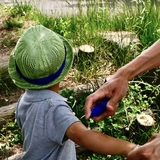Yellow Fever: The Disease & Vaccines
The yellow fever vaccine is required for entry into many countries in Africa and South America. The vaccine is also used in countries where yellow fever occurs, but the vaccine is not required for entry. The vaccine is given as a single shot to anyone older than 9 months of age, and may be given as a booster dose every 10 years for those who are at continued risk.
The disease
What is yellow fever?
Yellow fever is a virus that causes hepatitis (inflammation of the liver) and hemorrhaging (severe bleeding problems). Symptoms include fever, chills, muscle pain, headache and jaundice (yellowing of the skin). Bleeding and severe liver damage caused by yellow fever virus kills 1 of every 5 people infected with the virus.
Every year there are about 200,000 cases of yellow fever causing as many as 30,000 deaths worldwide.
Where can you catch yellow fever?
Transmitted by a simple mosquito bite, yellow fever occurs mostly in Africa and South America.
The yellow fever vaccine is recommended for travel to countries with risk of yellow fever transmission. To learn more about risk of yellow fever transmission relative to your travel destination, consult the Centers for Disease Control and Prevention's travel website.
How can you avoid yellow fever?
The best way to avoid yellow fever is to avoid being bitten by a mosquito. Between dusk and dawn, when mosquitoes most often appear to feed, you and your child should take refuge indoors. You should also:
- Use mosquito netting over the bed
- Wear long-sleeved shirts and long pants
- Wear insect-repellants with DEET on exposed skin
- Wear clothing treated with insect-repellants such as permethrin

Yellow Fever Q&A
Yellow Fever Special Topics Q&A

Infectious Disease and Travel Q&A
Infectious Disease and Travel Special Topics Q&A
The vaccine
How is the yellow fever vaccine made?
The yellow fever vaccine is made by growing yellow fever virus in mouse embryo cells and in chick embryo cells. The final preparation of the vaccine is made in eggs. Growing yellow fever virus in mouse and chick cells over and over again weakened it. Therefore, when this "live, weakened" virus is injected, a protective immune response develops without causing illness.
Who should not receive the yellow fever vaccine?
The following groups of people should not receive the yellow fever vaccine:
- Pregnant women
- Anyone with a weakened immune system (such as people with AIDS, or those receiving chemotherapy)
- Infants younger than 6 months of age
- Anyone with severe egg allergies
Does the yellow fever vaccine have side effects?
Minor side effects occur in fewer than 1 in 20 people and can include mild headaches, muscle aches or low-grade fevers. Severe side effects, specifically severe allergic reactions (hives, difficulty breathing, or low blood pressure) are extremely rare, occurring in less than 1 per 1 million people.
About 1 of every million people who receive the yellow fever vaccine can develop a disease that resembles yellow fever (called viscerotropic disease). This adverse reaction, which is occasionally fatal, occurs primarily in adults more than 65 years of age. However, when traveling to a country where yellow fever is common, the benefits of the yellow fever still outweigh this severe risk.
Other questions you might have
What is the youngest age that a child could receive the yellow fever vaccine?
The yellow fever vaccine is recommended for anyone older than 9 months of age. However, the vaccine can be given to those as young as 6 months if travel will occur in rural areas, small towns or villages with a high incidence of yellow fever infections.
Relative risks and benefits
Do the benefits of the yellow fever vaccine outweigh its risks?
Every year thousands of people in the world catch yellow fever and about one of every five die from the disease. Travelers from the United States to countries where yellow fever occurs can and do get yellow fever, and there are no specific agents to treat it. On the other hand, the yellow fever vaccine does not have serious side effects. Therefore, for those traveling to countries where yellow fever is common, the benefits of the yellow fever vaccine outweigh its risks.
Also, remember that the vaccine is not required for entry to some countries where the disease is common. The decision to get the vaccine should be based on whether you are traveling to a country where the disease is common, and not on whether the vaccine is required! (See special consideration for travelers to find a list of websites that contain the most recent information on vaccines for travel).
Disease risks
- Hepatitis (inflammation of the liver)
- Hemorrhaging (severe bleeding)
- Fever, chills, muscle pain, headache and jaundice (yellowing of the skin)
- Fatalities occur from severe bleeding and liver damage (1 of 5 people)
Vaccine risks
- Mild headaches, muscle aches or low-grade fevers (1 in 20 people)
- Severe allergic reaction (1 in 1 million people)
- Severe disease resembling yellow fever (viscerotropic disease) (1 in 1 million people)
References
Plotkin SA, Orenstein W, Offit PA, and Edwards KM. Yellow Fever Vaccine in Vaccines, 7th Edition. 2017,1181-1265.
Yellow Fever Vaccine. Centers for Disease Control and Prevention. Accessed March 1, 2019.
Reviewed by Paul A. Offit, MD, on March 01, 2019